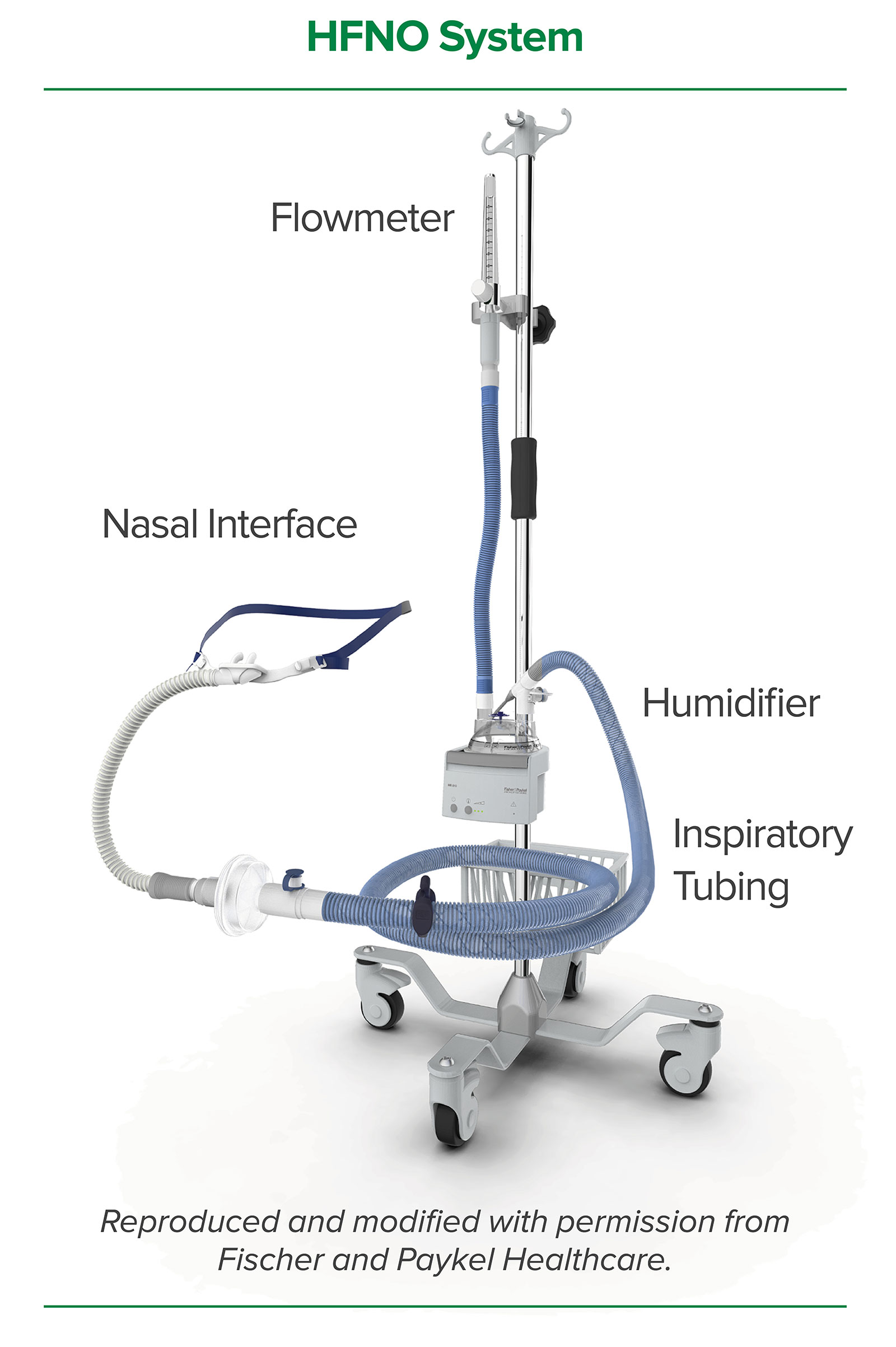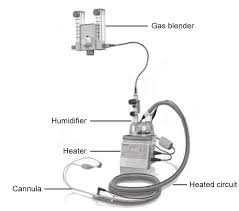heated high flow oxygen settings
Humidifier base FP MR 850 2. Whereas in adults and children the role of HFNC is mainly optimization of oxygen delivery the impact of high flow in neonates and infants is more importantly the created PEEP like CPAP.

How Does High Flow Nasal Cannula Hfnc Work Medmastery
Able to deliver adequately heated and humidified medical gas at flows up to 60 Lmin it is considered to have a number of physiological advantages compared with other standard oxygen therapies including reduced.

. Heated High Flow Oxygen using OptiFlow system at UIHC UIHC currently utilizes Fisher Paykels OptiFlow system to deliver Heated High Flow Oxygen Therapy This system is approved for use in the following areas. High-flow nasal cannula HFNC oxygen therapy is carried out using an airoxygen blender active humidifier single heated tube and nasal cannula. Study protocol for a randomized controlled trial SLOWH trial.
In recent years nasal cannulae designed to administer heated and humidified airoxygen mixtures at high flows up to 60 Lmin have been gaining popularity. High-flow nasal cannula HFNC therapy is an oxygen supply system capable of delivering up to 100 humidified and heated oxygen at a flow rate of up to 60 liters per minute. MICU CVICU SNICU PICU BICU ED RSCCU.
High-flow oxygen therapy can be used as a step between conventional oxygen therapy non-invasive ventilation or mechanical ventilation allowing the patient to receive level 2 care on the ward setting and possibly prevent admission to the intensive therapy unit ITU. They require more oxygen. High-flow nasal cannula aka heated humidified HFNC or high floe nasal prongs used in cases of hypoxic respiratory failure.
The flow rate and fi02 can. Need for high FiO2 oxygen delivery in settings such as. The AirSpiral heated breathing tube with integrated dual-spiral heated wires and temperature sensor.
The flow rate will then be weaned gradually as tolerated with no more than 1 Lmin decrease per day. 5 This system provides high-flow 30 to 60 LPM oxygen that is heated to body temperature 37 o C and is fully saturated 100 relative humidity with minimal or no rainout in the tubing. Intubation pre-oxygenation and apnoeic oxygenation.
Oxygen is adjusted to maintain SpO2 within target ranges of 92-96 for most patients and 88-92 for patients with chronic respiratory disease 8 9. High-flow oxygen administration by nasal cannula for adult and perinatal patients. In recent years nasal cannulae designed to administer heated and humidified airoxygen mixtures at high flows up to 60 Lmin have been gaining popularity.
It combines three common measurements. This flow rate will be continued until the infant is weaned off nCPAP. This includes a high-flow nasal cannula a high-flow source with systems regulating the flow and the FiO 2 a humidifier system and heated tubing.
It delivers high inspiratory gas flow up to 60 litres per minute which is warmed and humidified. Heat and humidified high flow nasal cannula or as most call it Hi Flow Nasal Cannula HFNC isnt just a standard nasal cannula cranked up to very high flow rates. It actually takes gas and can heat it to 37 o C with a 100 relative humidity and can deliver 021 100 fi02 at flow rates of up to 60 litersmin.
2020 Jan 1421 181. No separate temperature probes or adapters are required. Use of High Flow oxygen on the wards Introduction 41.
Oxygen therapy kit RT 329 including the auto feed chamber MR 290 3. FiO2 SpO2 and respiratory rate and it is based on two known facts about sicker patients. These high-flow nasal cannula HFNC systems enhance patient comfort and tolerance compared with.
Reduction of anatomical dead space PEEP. In order to optimize the humidification effect the temperature should be set at 37C. All settings are controlled independently allowing for greater confidence in the delivery of supplemental oxygen as well as better outcomes when used.
INTRODUCTION Oxygen is typically delivered via low-flow systems eg nasal cannulae or masks or high-flow systems eg Venturi masks nonrebreathers. The index has been validated in a multi-center prospective study conducted with 191 patients with pneumonia. Traditionally nasal oxygen therapy has been delivered at low flows through nasal cannulae.
6 The major indications for HFNC in neonates are thus the same as for nasal CPAP. HFNT has become increasingly used for management of patients with type 1 respiratory failure. Oxygen can be titrated 21-95.
High-Flow Oxygen Nasal Cannula HFNC Settings-Flow Rate 5 to 60 liters per minute - FiO2 021 to 10 - Initial Set Up Flow -may want to start at 20-35 liters per minute and titrate to to patients work of breathing WOB. Heated humidified high-flow HHHF therapy often also high flow nasal cannulae HFNC or high flow nasal oxygen HFNO is a type of respiratory support method that delivers a high flow liters per minute of medical gas to a patient through an interface nasal cannulae intended to create a wash-out of the upper airwayThe applied gas is heated to best match human body. It delivers adequately heated and humidified medical gas at up to 60 Lmin of flow and is considered to have a number of physiological effects.
They have a higher respiratory rate. Water for Irrigation 2 Litre Bag 4. Respiratory distress syndrome postextubation and apnea of prematurity.
Simultaneous reduction of flow and fraction of inspired oxygen FiO 2 versus reduction of flow first or FiO 2 first in patients ready to be weaned from high-flow nasal cannula oxygen therapy. FiO2 titrate to SpO2 goal With increasing flow rate may be able to decrease FiO2. High-flow nasal cannula HFNC oxygen therapy comprises an airoxygen blender an active humidifier a single heated circuit and a nasal cannula.
When compared with the 900PT501 Airvo tube in internal Fisher Paykel Healthcare testing. Such conventional systems do not deliver a reliable fraction of inspired oxygen and are generally poorly tolerated for prolonged periods due to inadequate warming and humidification of inspired gas. These high-flow nasal cannula HFNC systems enhance patient comfort and tolerance compared with traditional high-flow oxygenation systems such as nasal masks and nonrebreathing systems.

Safe Use Of High Flow Nasal Oxygen Hfno With Special Reference To Difficult Airway Management And Fire Risk Anesthesia Patient Safety Foundation

High Flow Oxygen Does It Make A Difference Rt

Difference Between High Flow Oxygen Therapy And Ventilator

Equipment Used For The Nasal High Flow Oxygen Therapy System We Used A Download Scientific Diagram

Pin By Nacho Redondo Garcia On Anestesia Acute Respiratory Failure Oxygen Medical

High Flow Nasal Cannula Youtube
The High Flow Nasal Cannula In The Emergency Department Emupdates

High Flow Oxygen Therapy Hfot Resmed Healthcare Professional

What Is A High Flow Nasal Cannula Hfnc Flow Oxygen Medical Equipment

What Is High Flow Nasal Cannula Hfnc Medmastery

An Introduction To The F P Airvo 2 For Optiflow Nasal High Flow Therapy Youtube

Introduction To The High Flow Nasal Cannula Ems Airway

How Does High Flow Nasal Cannula Hfnc Work Medmastery

Pin By Do On Respiratory Respiratory Therapy Student Respiratory Care Respiratory Therapy

High Flow Nasal Cannula Oxygen Therapy Devices Respiratory Care

What Is High Flow Nasal Cannula Hfnc Medmastery

Schematic Representation Of A High Flow Oxygen Device And Its Download Scientific Diagram

40 Vs 60 L Min What S The Difference Between Vapotherm High Velocity Therapy And High Flow Nasal Cannula Vapotherm

High Flow Nasal Cannula Oxygen Therapy Devices Respiratory Care